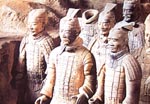The Vikings are preparing to cross the North Sea again.
Queen Margrethe of Denmark, whose ancestors once raided continental Europe and the British Isles, is expected to christen a replica of a 1,000-year-old Viking ship Saturday that was built with a more peaceful purpose.
Plans are for a crew of 60 men to sail the vessel, which builders said is the world's longest Viking ship reconstruction, to Britain and Ireland in 2007 along the routes once used by marauding Norsemen.
Antiquities Market update Ancient site in Indiana plundered
The secrets of a prehistoric village that once stood in Decatur County may remain locked away forever after thousands of ancient axes, arrowheads and other primitive tools were dug up and carted away.
Three southern Indiana men have been arrested in the case after conservation officers, following a tip, found the men digging with shovels, picks and garden hoes, said Steve Reinholt, a state Department of Natural Resources field officer.
Investigators found thousands of artifacts in the men's homes worth potentially tens of thousands of dollars, DNR officials said.
NEANDERTHAL LIFE NO TOUGHER THAN THAT OF “MODERN” INUITS
The bands of ancient Neanderthals that struggled throughout Europe during the last Ice Age faced challenges no tougher than those confronted by the modern Inuit, or Eskimos.
That’s the conclusion of a new study intended to test a long-standing belief among anthropologists that the life of the Neanderthals was too tough for their line to coexist with Homo sapiens.
And the evidence discounting that theory lies with tiny grooves that mar the teeth of these ancient people.
News from Gwent. Yes, Gwent. On trail of ancient crossing
ARCHAEOLOGISTS investigating the discovery of remains in Caerleon believe the timbers formed part of a 300-year-old bridge which once spanned the River Usk.
Timber remains were discovered by Environment Agency workers improving flood defences along Isca Road in Caerleon.
Experts from Gwent and Glamorgan Archaeological Trust believe the find is the remains of a bridge recorded as destroyed by a storm in 1772.
The main find consists of one pier of the bridge. It is a piece of oak seven metres long pierced by three mortice holes into which it is thought the tenons of three uprights that would have supported the road would be fitted.
Exploring the mysteries of Xi'an's imperial tombs
Dynasties and empires rose and fell along the Wei He River valley, where Xi'an lies. While the emperors are gone, their legacy awaits the spades and brushes of archaeologists exploring this crucible of Chinese history and culture.
The terracotta warriors, one of archaeology's greatest accidental finds, hint at what else could lie under the barely scratched fields where emperors and aristocrats lie interred beneath 500 burial mounds.
These tombs rise out of a fertile plain where orchards, renowned throughout Shaanxi for their crispy apples along with maize and other vegetables, form a pleasing agricultural mosaic. Come winter, the region takes on a starker beauty, eerie when dense fogs descend, shrouding the tombs.
Kind of a sensationalist article. If anyone ever gets around to to excavating some of these really big tombs, however, many of them will probably put Tutankhamun's to shame. In our opinion, the terra cotta warriors are way more impressive than anything found in the Valley of the Kings.
